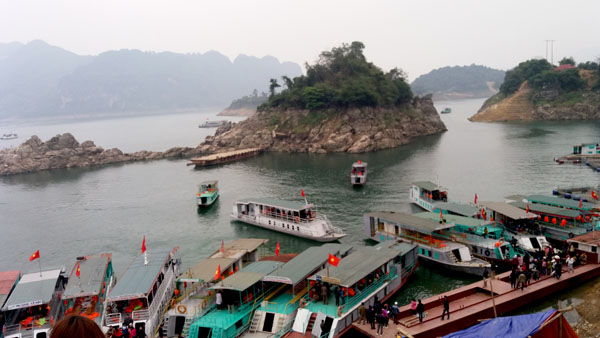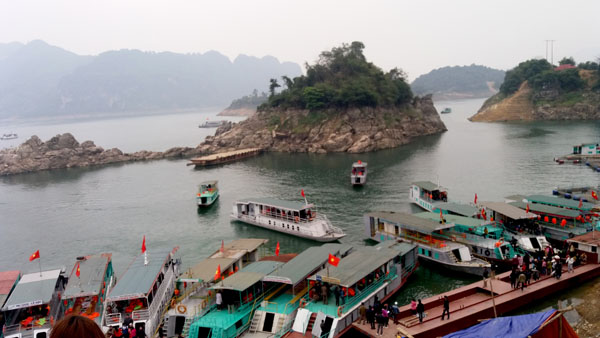
(Hoa Binh Online) – Hoa Binh lake in the northern province of Hoa Binh is home to nearly 20 ethnic groups, which boast long-standing, rich and special cultures.

Illustrative Image
Landscapes
within and around the lake are beautiful with immense water, mountains, caves
and temples. Values of historic legends of saints and ethnic identities from
pre-historic era are still maintained and brought into play.
There are 29 festivals in Muong ethnic group, 14 festivals in Thai group, 8
festivals in Mong group, 10 festivals in Dao group, and 14 ones in
Tay group.
At present, 38 festivals have been maintained, upheld and organised on a large
scale. Additionally, ethnic people perform ancestor worship rituals to pray for
peace and blessings for families and villages.
Apart from offerings, sacred and legendary music and dances are performed
throughout festivals, which attract visitors at home and abroad.
Tourists could enjoy fanciful scenery with stretching mountains, sparkling
islets on lakes, meet friendly, hardworking and simple-hearted people.
In order to travel to Hoa Binh lake tourist area, visitors could start off at
the centre of Hoa Binh city, then move to
Giang
Mo village, Binh Thanh commune,
Cao Phong district.
Leaving
Giang
Mo,
tourists continue to visit
Can
Cave on the right bank of
Hoa
Binh
Lake,
and
Tien
Phi
Caveon the left bank. These are beautiful caves with attractive stalactite poles in
various shapes. Sailing on boats, visitors will cruise the
Hoa
Binh
Lake.
Opening in front of their eyes are a massive water area with hundreds of
islands and archipelagoes. They will enjoy fresh, interesting and amazing
moments thanks to the beautiful landscape of a new land, which is fanciful with
spectacular mountains.
Visitors may stop at Bo Temple. Before the dam of the Hoa Binh hydropower plant
was built, Bo temple was right in the centre of Thac Bo. Locals then moved the
temple to a higher place to free the
Hoa
Binh
Lakebasin for the work. As the
Hoa
Binh
Lakewas completed, Thac Bo was reconstructed in the top of a hill in Thung Nai
commune, Cao Phong district.
It is said that in 1431-1432, King Le Loi was on the way to Muong Le of Hoa
Binh’s neighbouring province of Son La to fight enemy when he met obstacles in
tough Thac Bo area and received support in food and boat by locals, including
Dinh Thi Van, a Muong woman in Hao Trang commune and a Dao woman in Mo Ne
village, Vay Nua commune.
When the two women passed away, King Le Loi honoured them and ordered the
construction of worship altars for them.
The Bo Temple’s festival is on the seventh day of the first lunar month. The
temple is home to 38 statues in different sizes, including two bronze ones.
Tourists may also visit Ret and Hoa Tien caves, Thac Goddess Temple, Co and
Cau
Templesas well as some villages of Muong or Dao people.
Continuing the trip, visitors will enter a sightseeing tour in surprising and
unique landscapes of the locality. The natural landscapes seems to have magical
power to make their soul relaxed without any dust of life, enabling them to
enjoy miraculous gifts from the nature.
On top of nice things that are toughing to visitors is the hospitality and
friendliness of locals. In any place in Hoa Binh, they feel warmth and
happiness thanks to the friendly smiles and hand-shakings of local people in
Hoa Binh.
HB
In the first 9 months of 2024, Hoa Binh province continues to implement the expanded tourism development cooperation program plan of 8 Northwest provinces with Ho Chi Minh City; deploying digital transformation content in tourism and developing a smart tourism province. Hoa Binh province received about 3.6 million views, an increase of 7.9% over the same period. In which, international visitors are about 380 visitors, domestic visitors are estimated at 3 million 220 visitors.
Spanning thousands of hectares and winding gracefully along mountain slopes, hillsides, and riverbanks, the terraced rice fields of Lac Son District present a stunning and captivating beauty. This region, renowned for its remarkable terraced landscapes, is also the centre of Hoa Binh Culture known for numerous archaeological sites.
The life of Mong people in Hang Kia and Pa Co communes of Mai Chau district has improved much thanks to tourism development.
The man-made Hoa Binh Lake, with a water surface area of approximately 9,000 hectares and a capacity of 9.45 billion cubic meters, stretches over 200 kilometers from Hoa Binh to Son La provinces. With the goal of developing into a national tourism area, the Hoa Binh Lake tourism area is expected to not only become the largest tourism centre in the province but also one of the 12 key tourist destinations in the northern midland and mountainous region of Vietnam.
Da Bia hamlet, now Duc Phong, in Tien Phong commune, Da Bac district, was once almost isolated from the outside as the only way to the hamlet was to get a boat ride across the Hoa Binh reservoir. However, as its tourism potential has been unleashed, the hamlet has established itself as one of the most attractive destinations on the tourism map. It has even received the ASEAN Community-Based Tourism Awards in 2019.
In the first 9 months of 2024, Mai Chau district, Hoa Binh province welcomed over 684 thousand visitors to visit and relax. In which, over 516 thousand domestic visitors and more than 168 thousand international visitors. Total revenue from tourism is estimated at over 821 billion VND.



